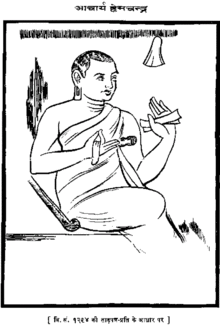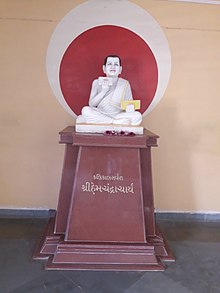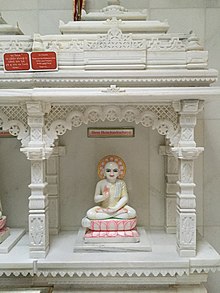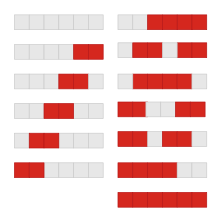Hemachandra
Acharya Hemachandra Suri | |
|---|---|
 Drawing of Hemchandra based onVikram Samvat1294 palm leaf | |
| Official name | Acharya Hemchandra Suri |
| Personal | |
| Born | Changadeva c. 1088(see notes) |
| Died | c. 1173(see notes) |
| Religion | Jainism |
| Parent(s) | Chachinga, Pahini |
| Sect | Śvētāmbara |
| Notable work(s) | Siddha-Hema-Śabdanuśāśana, Yogasastra |
| Religious career | |
| Initiation | Somchandra Khambhat by Devchandrasuri |
| Post | Acharya (Jainism) |
| Part ofa serieson |
| Jainism |
|---|
 |
Hemachandrawas a 12th century (c. 1088– c. 1172/1173 CE) IndianJainsaint, scholar, poet, mathematician,philosopher,yogi,grammarian,[1]law theorist,[2][3]historian,[4]lexicographer,rhetorician,logician,andprosodist.[5]Noted as a prodigy by his contemporaries, he gained the titlekalikālasarvajña,"the knower of all knowledge in his times" andfather of the Gujarati language.
Born as Changadeva, he was ordained in theŚvētāmbaraschool of Jainism in 1110 and took the name Somachandra. In 1125 he became an adviser to King Kumarapala and wroteArhanniti,a work on politics from a Jain perspective. He also producedTrishashti-shalaka-purusha-charita( “Deeds of the 63 Illustrious Men” ), a Sanskrit epic poem on the history of important figures of Jainism. Later in his life, he changed his name to Hemachandra.
Early life
[edit]Hemachandra was born inDhandhuka,in present-dayGujarat,on Kartika Sud Purnima (the full moon day of Kartika month). His date of birth differs according to sources but 1088 is generally accepted.[note 1][6]His father, Chachiga-deva was a Modh BaniaVaishnava.His mother, Pahini, was aJain.[7][8]Hemchandra's original given name was Changadeva. In his childhood, theJain monkDevachandra Suri visited Dhandhuka and was impressed by the young Hemachandra's intellect. His mother and maternal uncle concurred with Devachandra, in opposition to his father, that Hemachandra be a disciple of his. Devachandra took Hemachandra toKhambhat,where Hemachandra was placed under the care of the local governor Udayana. Chachiga came to Udayana's place to take his son back, but was so overwhelmed by the kind treatment he received, that he decided to willingly leave his son with Devachandra.[9]
Some years later, Hemachandra was initiated a Jain monk on Magha Sud Chauth (4th day of the bright half of Magha month) and was given a new name, Somchandra. Udayana helped Devchandra Suri in the ceremony.[7][8]He was trained in religious discourse, philosophy, logic and grammar and became well versed in Jain and non–Jain scriptures. At the age of 21, he was ordained anacharyaof theŚvētāmbaraschool of Jainism atNagaurin present-dayRajasthan.At this time, he was named Hemachandra Suri.[7][8][10][11]
Hemachandra and Siddharaja
[edit]
At the time, Gujarat was ruled by theChaulukya dynastyfromAnhilavada(Patan). It is not certain when Hemachandra visited Patan for the first time. As Jain monks aremendicantsfor eight months and stay at one place duringChaturmas,the four monsoon months, he started living at Patan during these periods and produced the majority of his works there.[7][8]
Probably around 1125, he was introduced toJayasimha Siddharaja(fl.1092–1141) and soon rose to prominence in the Chaulukya royal court.[8]According to thePrabhavakacaritaofPrabhācandra,the earliest biography of Hemachandra, Jayasimha spotted Hemachandra while passing through the streets of his capital. The king was impressed with an impromptu verse uttered by the young monk.[12]
In 1135, when Siddharaja conqueredMalwa,he brought the works ofBhojafrom Dhar along with other things. One day Siddhraja came across the manuscript ofSarasvati-Kanthabharana(also known as theLakshana Prakash), a treatise onSanskrit grammar.He was so impressed by it that he told the scholars in his court to produce a grammar that was as easy and lucid. Hemachandra requested Siddharaja to find the eight best grammatical treatises fromKashmir.He studied them and produced a new grammar work in the style ofPāṇini'sAṣṭādhyāyī.[7][8]He named his workSiddha-Hema-Śabdanuśāśanaafter himself and the king. Siddharaja was so pleased with the work that he ordered it to be placed on the back of an elephant and paraded through the streets of Anhilwad Patan.[13]Hemachandra also composed theDvyashraya Kavya,an epic on the history of theChaulukya dynasty,to illustrate his grammar.[8]
Hemachandra and Kumarapala
[edit]
According to thePrabhachandra,there was an incident where Siddharaja wanted to kill his nephewKumarapalabecause it was prophesied that the kingdom would meet its demise at Kumarapala's hands. Hemachandra hid Kumarapala under a pile of manuscripts to save him.[7]However, such motifs are common in Indian folk literature, so it is unlikely it was an actual historical event. Also, many sources differ on Siddharaja's motives.[7]
Hemachandra became the advisor to Kumarapala.[7][8]During Kumarapala's reign, Gujarat became a center of culture. Using the Jain approach ofAnekantavada,Hemchandra is said to have displayed a broad-minded attitude, which pleased Kumarapala.[10]Kumarapala was aShaivaand ordered the rebuilding ofSomnathatPrabhas Patan.Some Hindu saints who were jealous of Hemachandra's rising popularity with the Kumarapala complained that Hemachandra was a very arrogant person, that he did not respect thevedic deitiesand that he refused to bow down to Hindu GodShiva.When called upon to visit the temple on the inauguration with Kumarapala, Hemachandra readily bowed before thelingambut said:
Bhava Bijankaura-janana Ragadyam Kshayamupagata Yasya, Brahma va Vishnu va Haro Jino va Namastasmai.
I bow down to him who has destroyed the passions like attachment and malice which are the cause of the cycle of birth and death; whether he isBrahma,Vishnu,ShivaorJina.[10][14]
Ultimately, the king became a devoted follower of Hemachandra and a champion of Jainism.[7][10]

Starting in 1121, Hemachandra was involved in the construction of theJain templeatTaranga.His influence on Kumarapala resulted in Jainism becoming the official religion of Gujarat and animal slaughter was banned in the state. The tradition ofanimal sacrificein the name of religion was completely uprooted in Gujarat. As a result, even almost 900 years after Hemchandra, Gujarat still continues to be a predominantlylacto-vegetarianstate, despite having an extensive coastline.[7][8]
Death
[edit]He announced about his death six months in advance and fasted in his last days, a Jain practice calledsallekhana.He died at Anhilavad Patan. The year of death differs according to sources but 1173 is generally accepted.[6]
Works
[edit]A prodigious writer, Hemachandra wrotegrammarsofSanskritandPrakrit,poetry,prosody,lexicons,texts onscienceandlogicand many branches ofIndian philosophy.
Jain philosophy
[edit]
His systematic exposition of the Jain path in theYogaśāstraand its auto-commentary is a very influential text in Jain thought. According to Olle Quarnström it is "the most comprehensive treatise onŚvetāmbaraJainismknown to us ".[15]
Grammar
[edit]
TheSiddha-Hema-Śabdanuśāśanaincludes six languages:Sanskrit,the "standard"Prakrit(virtuallyMaharashtri Prakrit),Shauraseni,Magahi,Paiśācī,the otherwise-unattested Cūlikāpaiśācī andApabhraṃśa(virtually Gurjar Apabhraṃśa, prevalent in the area of Gujarat andRajasthanat that time and the precursor ofGujarati language). He gave a detailed grammar of Apabhraṃśa and also illustrated it with the folk literature of the time for better understanding. It is the only known Apabhraṃśa grammar.[8]He wrote the grammar in form of rules, with 8 Adhyayas (Chapters) and "Tattvaprakaashika prakash" with "maharnav nyaas" in one year.Jayasimha Siddharajahad installed the grammar work in Patan's (historically Anhilpur) state library. Many copies were made of it, and many schemes were announced for the study of the grammar. Scholars named Kaakal and Kaayasth took great efforts to teach the grammar.[16]
Politics
[edit]In 1125, he became an adviser to Kumarapala and wrote theArhanniti,a work on politics from a Jain perspective.[17][2]
Poetry
[edit]
To illustrate the grammar, he produced the epic poetryDvyashraya Kavyaon the history ofChaulukya dynasty.It is an important source of history of region of the time.[8]Theepic poemTrīṣaṣṭiśalākāpuruṣacharitraor "Lives of Sixty-Three Great Men" is ahagiographical treatmentof the twenty fourtirthankarasand other important persons instrumental in defining the Jain philosophical position, collectively called the "śalākāpuruṣa",their asceticism and eventual liberation from the cycle of death and rebirth, as well as the legendary spread of the Jain influence. It still serves as the standard synthesis of source material for the early history of Jainism.[8]The appendix to this work, thePariśiṣṭaparvanorSthavirāvalīcarita,[18]contains his own commentary and is in itself a treatise of considerable depth[8]It has been translated into English asThe Lives of the Jain Elders.[19]In the test, Hemchandra accepts the polyandry ofDraupadiand further suggests that Draupadi was Nagasri in one of her previous lives and had poisoned a Jain monk. Therefore, she had to suffer in hell and animal incarnations for several lives before being born as woman who later became a Jain nun. After her death, she was reborn as Draupadi and was married to five pandavas.[20]HisKavyanuprakashafollows the model of Kashmiri rhetorician Mammata'sKavya-prakasha.He quoted other scholars likeAnandavardhanaandAbhinavaguptain his works.[8]
Lexicography
[edit]Abhidhan-Chintamani(IAST abhidhāna-cintāmaṇi-kośa) is alexiconwhileAnekarth Koshais a lexicon of words bearing multiple meanings.Deshi-Shabda-SangrahoorDesi-nama-malais the lexicon of local or non-Sanskrit origin.Niganthu Sesais a botanical lexicon.[8]
Prosody
[edit]He composed theChandonushasana,a work onprosody,with commentary.
Mathematics
[edit]
Hemachandra, following the earlier Gopala, described theFibonacci sequencein around 1150, about fifty years beforeFibonacci(1202). He was considering the number of cadences of lengthn,and showed that these could be formed by adding a short syllable to a cadence of lengthn− 1, or a long syllable to one ofn− 2. This recursion relationF(n) =F(n− 1) +F(n− 2) is what defines the Fibonacci sequence.[21][22]
He (c. 1150 CE) studied the rhythms of Sanskrit poetry. Syllables in Sanskrit are either long or short. Long syllables have twice the length of short syllables. The question he asked is How many rhythm patterns with a given total length can be formed from short and long syllables? For example, how many patterns have the length of five short syllables (i.e. five "beats" )? There are eight: SSSSS, SSSL, SSLS, SLSS, LSSS, SLL, LSL, LLS. As rhythm patterns, these are xxxxx, xxxx., xxx.x, xx.xx, x.xxx, xx.x., x.xx., x.x.x[23]
Other works
[edit]His other works are a commentary in rhetoric workAlankara Chudamani,Abhidhana-chintamani,[7][24]Pramana-mimansa(logic),Vitaraga-Stotra(prayers).[8]
See also
[edit]Notes
[edit]- ^The dates of birth and death differs according to sources. He was initiated aged 21.
- As perDundas,(1089–??)[7]
- As perDattaandJain World,(1088–1173)[8][10]
- As perGujarat Gazetteers, Volume 18,(1087–1174)[25]
- As perIndian Merchants and Entrepreneurs,(1089–1173)[26]
References
[edit]Citations
[edit]- ^Datta, Amaresh (1987).Encyclopaedia of Indian Literature: A-Devo.Sahitya Akademi. pp. 15–16.ISBN978-81-260-1803-1.
- ^abFlügel, Peter."A Short History of Jaina Law":5.
{{cite journal}}:Cite journal requires|journal=(help) - ^"Hemachandra | Jaina author | Britannica".britannica.Retrieved7 February2022.
- ^Singh, Upinder (2008).A History of Ancient and Early Medieval India: From the Stone Age to the 12th Century.Pearson Education India. p. 241.ISBN978-81-317-1677-9.
- ^Datta, Amaresh (1987).Encyclopaedia of Indian Literature: A-Devo.Sahitya Akademi. p. 15.ISBN978-81-260-1803-1.
- ^abJoshi, Dinkar (1 January 2005).Glimpses of Indian Culture.Star Publications. pp. 79–80.ISBN978-81-7650-190-3.
- ^abcdefghijklDundas, Paul (2002).The Jains.Psychology Press. pp. 134–135.ISBN978-0-415-26606-2.
- ^abcdefghijklmnopqDatta, Amaresh; various (1 January 2006).The Encyclopaedia Of Indian Literature (A To Devo).Vol. 1. Sahitya Akademi. pp. 15–16.ISBN978-81-260-1803-1.
- ^Asoke Kumar Majumdar 1956,p. 97.
- ^abcde"Hemacandra".Jain World. Archived fromthe originalon 29 April 2008.Retrieved6 May2008.
- ^Pandit, Shankar Pandurang, ed. (1936).The Kumarapalacarita (Prakrta Dvyasraya Kavya) of Hemachandra with commentary of Purnakalashagani.Bombay Sanskrit and Prakrit Series Book LX. P. L. Vaidya (revision) (2 ed.). Poona: The Bhandarkar Oriental Institute. pp. xxiii–xxv.
- ^Asoke Kumar Majumdar 1956,p. 83.
- ^Meghani, Jhaverchand(2003).A Noble Heritage: A Collection of Short Stories Based on the Folklore of Saurashtra.Bharatiya Vidya Bhavan. p. xviii.
- ^Encyclopaedia of Oriental Philosophy.Global Vision Pub House. 2005. p. 278.ISBN978-81-8220-113-2.
- ^Olle Quarnström, The Yogasastra of Hemacandra: a twelfth century handbook of Svetambara Jainism, 2002, introduction
- ^'Prastaavna', Haim Sanskrit Praveshika by Pandit Shivlal Nemchand Shah, Bhadrankar Prakashan.
- ^"Hemachandra | Jaina author | Britannica".britannica.Retrieved14 November2021.
- ^Upinder Singh 2016,p. 26.
- ^Hemacandra; R. C. C. Fynes (1998).The Lives of the Jain Elders.Oxford University Press.ISBN978-0-19-283227-6.
- ^Doniger 1993,p. 241.
- ^Koshy, Thomas (2001).Fibonacci and Lucas numbers with applications.John Wiley & Sons.ISBN9780471399698.
... before Fibonacci proposed the problem; they were given by Virahanka (between 600 and 800 AD), Gopala (prior to 1 135 AD),...
- ^Tetlow, Philip (2007).The Web's awake: an introduction to the field of Web science and the concept.John Wiley & Sons.ISBN978-0-470-13794-9.
This sequence was first described by the Indian mathematicians Gopala and Hemachandra in 1150, who were investigating the possible ways of exactly packing items of length 1 and 2 into containers. In the West it was first studied by...
- ^"Archived copy"(PDF).Archived fromthe original(PDF)on 3 March 2019.Retrieved24 September2019.
{{cite web}}:CS1 maint: archived copy as title (link) - ^Olle Quarnström (2002), The Yogaśāstra of Hemacandra: A Twelfth Century Handbook of Śvetāmbara Jainism, Harvard University Press,ISBN978-0674009349
- ^Gujarat (India) (1984).Gazetteers.Directorate of Government Print., Stationery and Publications. p. 183.
- ^Mehta, Makrand (1 January 1991).Indian Merchants and Entrepreneurs in Historical Perspective: With Special Reference to Shroffs of Gujarat, 17th to 19th Centuries.Academic Foundation. p. 65.ISBN978-81-7188-017-1.
Sources
[edit]- Doniger, Wendy,ed. (1993),Purana Perennis: Reciprocity and Transformation in Hindu and Jaina Texts,State University of New York Press,ISBN0-7914-1381-0
- Asoke Kumar Majumdar (1956).Chaulukyas of Gujarat.Bharatiya Vidya Bhavan.OCLC4413150.
- Singh, Upinder(2016),A History of Ancient and Early Medieval India: From the Stone Age to the 12th Century,Pearson Education,ISBN978-93-325-6996-6
- Cinnaiya, S., Nayara, H. K., &Mathura,R. (2017).Cakita kare Fibonācī.Bengaluru:Pratham Books.
Further reading
[edit]- Hemacandra.SthavirāvalīcaritaorPariśiṣṭaparvan,ed. H. Jacobi, Calcutta, 1883; trans. Fynes (1998).
- Hemacandra.Yogaśāstra,ed. Muni Jambūvijaya, 3 vols, Bombay, 1977–86.
External links
[edit]- Trishashti Shalaka Purusha Caritra of HemchandraEnglish translation of books 1-10
- Bibliography of Hemachandra's works, Item 687Archived13 November 2021 at theWayback Machine,Karl Potter, University of Washington
- Acharya Hemchandra by Madhya Pradesh Hindi Granth Academy
- The Rhythm of Poetry
- The Golden Mean and the Physics of Aesthetics
- 1080s births
- 1172 deaths
- 12th-century Indian mathematicians
- 12th-century Indian philosophers
- Jain acharyas
- History of Gujarat
- Fibonacci numbers
- Gujarati-language writers
- Gujarati people
- Cultural history of Gujarat
- Indian Jain monks
- 12th-century Indian Jain poets
- 12th-century Jain monks
- 12th-century Indian monks
- Jain law
- Indian male writers
- 12th-century Indian historians
- Scholars from Gujarat
- Śvetāmbara monks

